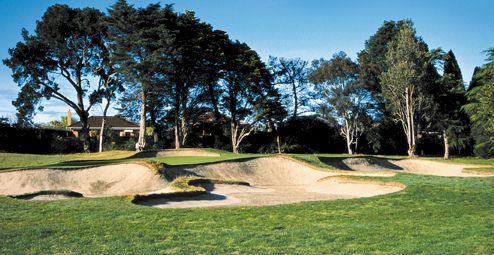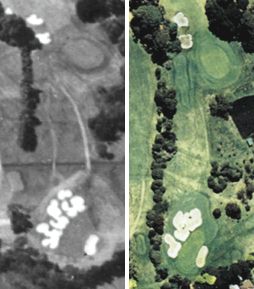This article courtesy of the Golf Architecture Magazine
The 11th Hole, Par 3, 165 metres
Yarra Yarra Golf Club
Melbourne, Victoria
Hole Architect – Alex Russell

Russell's bunkering at the 11th, although somewhat modified since he built it in 1927-28 is still some of the most spectacular bunker work in the country.
When analysing the Yarra Yarra layout, you’re hardly sticking your neck out by declaring that two holes qualify as world class - the 5th and 11th holes. Yet, the 11th at Yarra Yarra differs markedly from other classic Melbourne sand belt holes. Here, the challenge and allure is all greenside, for in truth, the tee to green vista is distinctly uninspiring, and the housing visible behind the green is jarring.
With many fabled sand belt holes, for example, the 5th, 6th, 10th, and 17th holes at Royal Melbourne’s West Course, Commonwealth’s 11th hole, or Kingston Heath’s 15th, it becomes quickly apparent that the green complexes are just one aspect of their appeal – vegetation, the lie of the land, inherent strategy, framing and a sense of grandeur, all serve to round out the picture.
 For the men, Yarra’s 11th hole measures 165 metres to the centre of the green, with 149m needed to clear the front bunker. Sporting just one teeing ground for both sexes - at nearly fifty paces, among the longest in Melbourne - the hole plays at 135m for women. Due to the green being orientated on a left to right axis, the tee shot must be airborne for 158m to make it over the right rear bunker, where any ball not shaped right to left will surely be devoured by sand. One of the favoured championship pin positions is in the back right portion of the green, only 13m in width. The tee-shot distance to reach this section is a testing 169m. In total, the treacherous three-tiered green is 32m in length and barely 15m at its widest, tapering down to around 10m at the front. Since its institution, one thing has never changed on the tee - any celebrations following a well-struck iron must be held in check. This green is notoriously difficult to hold.
For the men, Yarra’s 11th hole measures 165 metres to the centre of the green, with 149m needed to clear the front bunker. Sporting just one teeing ground for both sexes - at nearly fifty paces, among the longest in Melbourne - the hole plays at 135m for women. Due to the green being orientated on a left to right axis, the tee shot must be airborne for 158m to make it over the right rear bunker, where any ball not shaped right to left will surely be devoured by sand. One of the favoured championship pin positions is in the back right portion of the green, only 13m in width. The tee-shot distance to reach this section is a testing 169m. In total, the treacherous three-tiered green is 32m in length and barely 15m at its widest, tapering down to around 10m at the front. Since its institution, one thing has never changed on the tee - any celebrations following a well-struck iron must be held in check. This green is notoriously difficult to hold.
above - Miss the green to the right of the bunkers and this is the daunting shot that awaits.

Acknowledgment of senior and shorter-hitting golfers has made it important to offer respite to those incapable of carrying the front bunker. And so, the club maintains a tightly mown chipping and pitching area commencing some twenty metres short of the green, extending leftward and up level with the start of the left-hand bunker. It is known locally as Scotchman’s Hill. No safe haven though awaits golfers to the right of the green.
left - Alex Russell's original bunkering (left) to his famed 11th at Yarra Yarra was still intact in 1952, in the oblique aerial view to the north-east, and (right) as it appears today from the air. Russell's bunkering has been notably altered over the years.Alex Russell was fond of his handiwork at the short holes at Yarra Yarra Golf Club, but surprisingly, the 15th hole was his personal favourite. In the April 21, 1928 edition of “The Sporting Globe”, sports writer J. M. Dillon reviewed the course and wrote:
“The short hole that, of the four one-shotters, appealed mostly to me was the 180 yards 11th. The green is skewed right around, and right in front and up against the putting surface is a line of nasty and effective looking sand traps. A full iron with stop is the shot called for…..Russell’s favourite short hole is the up hill one - the 15th - to a green that has a level patch and then a step up to the putting green proper.”
Popular myth has overly exaggerated the uphill nature of the eleventh hole, and this trickery is further reinforced while peering from the tee. Yet, after positioning oneself halfway up the hole and to the side, the observer will discard this myth at once. The hole rises ever so gradually, with the green perhaps lying only five metres above tee level.
As with many holes on the sand belt, the bunkering is the key element. It announces on the tee - then amplifies -the difficulty of the hole, and clearly defines the challenge.
Bunker rationalisation and re-design aside, little has altered at Yarra’s classic par 3 over the years, save for a softening to the lower sections of the green in 1991 to allow more pin positions and avert the danger of putting off the green - by all accounts, a once regular occurrence in the height of summer. Minor surgery was carried out to the rear section of the green in 2000.
Each year during the Women’s Australian Open, female supremacy comes to the fore on this hole. By contrast, male golfers thrown into a mental spin over reaching the green, usually fall victim to pride. Alarming physical and chemical changes take hold - enough adrenaline surges to fight an army - and invariably, the ‘flogged’ long iron is forced and the result is more than forgettable. Women, too, hear the same doubting ‘voice’, but instead take heed and sensibly opt for enough club. During the tournament, it is a joy to watch their five and seven wood shots parachuting in from a sufficient height to hold the precariously tilting green.
Safe negotiation of this hole is crucial to compiling a good score at Yarra Yarra. While routine golf along the 8th and 9th fairways, allied to fine pitching, may produce birdies at these par 5’s, the score in progress can be flattering. Coming at this point in the round, the 11th is the perfect swing and score reality check. Because of its difficulty, a bogey is never automatically a shot dropped to the field, but so often golfers score far worse. In short, Yarra’s 11th is one of the most efficient scorecard wreckers in Australian golf.

this is the view from the line of the tee shot and shows how the right side bunkering is set obliquely to this line. A back left bunker will capture the pulled approach.
Yarra Yarra has fought a long-running battle with drainage problems, with its 11th and 12th fairways among the holes worst affected. These low lying areas of the course are naturally prone to inundation, and in the past, additional run-off from surrounding market gardens was problematic. In 1954, on the eve of the Ampol Tournament, heavy rains caused the 11th hole to be a veritable tee to green ocean, resembling more closely an American par 3 over water - the event was subsequently transferred to Huntingdale. Thankfully, such calamities are a thing of the past, but even so, a large drainage grate is positioned thirty metres short of the green on standby for such emergencies.
When discussing their favourite or ‘best’ hole in Melbourne, social grace dictates that golfers will normally ‘agree to disagree’. However, in 1991 a large group of leading Australian and New Zealand golf professionals were asked directly to nominate the best hole in the state of Victoria. Interestingly, the hole selected and publicised in Melbourne’s “Sunday Age” newspaper was not one of a dozen possibilities on the Royal Melbourne complex, nor the awe-inspiring 15th hole at Kingston Heath, nor Victoria’s, Metropolitan’s, Woodland’s, Commonwealth’s or Huntingdale’s finest. Indeed, you’ve guessed it - it was Yarra Yarra’s 11th. Trumping that collection of wonderful holes is high praise indeed!
by Paul Daley


